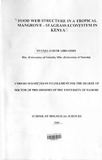| dc.description.abstract | The aim of this study was to assess the role of primary producers in supporting food webs
leading to fisheries productivity in a tropical mangrove estuary, Gazi Bay, Kenya. A
combinationof carbon and nitrogen stable isotope analysis and fish gut content analysis were
usedto (i) trace the food-web structure of commercially and ecologically important fish; and (ii)
to quantitatively determine whether the fish community is dependent on mangroves or seagrasses
as theirbase of nutritional support.
Three sampling locations representing mangrove and seagrass habitats were established in
GaziBay. Within each location, replicate samples were collected for all the variables examined
in this study including: fish; benthic macroinvertebrates; potential primary food / organic carbon
sources i.e. mangroves, seagrasses, seagrass epiphytes, macroalgae; suspended particulate
organicmatter (SPOM); dissolved inorganic carbon (DIC); and sediment organic matter (SOM).
The autotrophic carbon sources supporting fisheries in the bay was studied through carbon ((313C)
and nitrogen ((3lsN)stable isotope analysis (SIA) of muscle tissues of various fish species,
enthic macroinvertebrates 'and a range of potential primary food sources.
The results showed that man~r?ves had the most depleted 13Csignatures averaging -27.7
±: 1.4 %0, followed by macroalgae (-20.4 ± 3.1 %0) and seagrasses (-15.1 ± 3.0 %0) were the most
3C-enriched.There was con~iderable overlap in the (3!3C;igmitures between fish (-16.1 ± 2.1
~o), seagrasses (-15.1 ± 3.0 %0), seagrass epiphytes (-13.6 ±~~.3 %0) and macroalgae (-20.4 ± 3.1
60). Nevertheless, the signatures for most primary producers were sufficiently distinct indicating
hat the dominant sources of carbon for fish are mainly the seagrass and their associated epiphyte
ommunity, and possibly macroalgae. Mangrove-derived organic matter had a limited
intribution to the overall fish food web. While investigating fish feeding habitats, the results
showedthat fishes from the mangrove creeks had distinctly lower 813C signatures (-16.8 ± 2.0
%0) compared to those collected in the adjacent seagrass beds (-14.7 ± 1.7 %0). This indicated that
these habitats acted as distinct sheltering and feeding zones for the fishes collected, although
thereis frequent migration of fishes between mangrove and seagrass habitats influenced by tidal
fluctuationsin the Bay.
Studies on the benthic macroinvertebrate community structure indicated significantly high
macroinvertebrate density in the sediments within the mangrove forest (11524 ± 2925 indo m-2)
and seagrass beds (11671 ± 2082 indo rn"), as compared to the unvegetated sand flats (3772 ±
956indom-2
) (ANOVA, F = 8.0318, P = 0014). The dominant macro invertebrate taxa in the Bay
were:Polychaeta (29 %), Oligochaeta (27 %), Amphipoda (16 %) and Tanaidacea (14 %).
Frequency analysis of all examined specimens showed that 67 % of macro invertebrate
carbonisotopic signatures fell between -22 %0 and -18 %0, while 23 % had values between -18 %0
and -14 %0.These values fall within the carbon isotopic signatures range observed for Sediment
Organic Matter (SaM), Suspended Particulate Organic Matter (SPOM), seagrass and their
attached seagrass epiphytes. This overlap emphasizes the contribution of carbon from these
organicmatter sources to the benthic food web.
A comparative study on stable isotope ratios (8I3C; {)ISN) and gut content analysis (OCA)
of 13 selected fish species was carried out. 813C for fishes ranged between -22.5 %0 and -14.0 %0,
with averages of -17.1 ± 0.8-%0, -16.5 ± 1.0 %0, -15.2~± 0.3 %0 and -17.6 ± 1.0 %0 for
fish/invertebrate feeders (piscivore/zoobenthivores), invertebrate feeders (zoobenthivores),
omnivorousand herbivorous fishes, respectively. It was observed that gut content of most fishes
classifiedas fish/invertebrate feeders and pure invertebrate feeders had high proportion of benthic
crustaceans (mainly amphipods and copepods), Outs of herbivorous fishes were dominated by
plant material, although Siganus sp. also fed on some amphipods, copepods, tanaidacea and
nematodes,which indicated the presence of omnivory for the siganids. Stable isotope and gut
content analysis showed clear food resource partitioning between the dominant herbivorous
fishes(Siganus sutor and Leptoscarus vaigiensis). Siganus sp. fed on macroalage and epiphytes,
whileL. vaigiensis fed on a large proportion seagrass in addition to macroalgae and epiphytes.
Overall,results from both SIA and GCA pointed at the opportunistic feeding strategy adopted by
mostfishes. This, therefore, means that fishes ate available and accessible prey that sometimes
wasnot easy to assimilate.
Quantitative measure on the relative contribution of various organic matter sources to the
dietof dominant herbivores (Siganus sutor and Leptoscarus vaigiensis) was carried out using an
IsoSourceModel. The model estimates of feasible contributions of each organic matter indicated
differencesin the diet of S. sutor and L. vaigiensis. The model emphasized the importance of
SPOMand epiphytes in the diet of S. sutor as shown by their relatively high proportional
contributionin their diet (for example me,dian contribution for SPOM and epiphytes was 34 %
and 25 %, respectively). Conversely,' the IsoSource model confirmed the high nutritional
importance of seagrass and epiphytes in the diet of L. vaigiensis (median contribution for
seagrassand epiphytes was 52 % and 39 %, respectively).
From these results, we conclude that many coastal fishesderive their primary carbon from
seagrassbeds either directly through grazing or indirectly t~.rough trophic linkages in the detrital
foodweb. There is minimal use of mangrove habitats as feeding grounds for fishes, but this
habitat still supports other ecological functions in the ecosystem, which indirectly enhances
fisheries productivity. Therefore, due to -the ecological connectivity between mangroves and
seagrass ecosystems, integrated management of the two systems is necessary to sustain the
productivityof coastal fisheries . | en |

